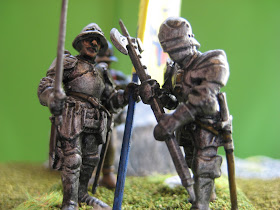I have had a long term interest in the Wars of the
Roses. My book shelves are dotted with numerous volumes, most excitingly
entitled ‘The Wars of the Roses’, and, many years ago, I painted up an army,
mostly made up of Wargames Foundry miniatures. That army was subsequently sold
to a guy who worked for Games Workshop in Nottingham. Put this historical
passion and my current addiction to plastic miniatures together and shelling
out my hard earned cash on Perry Miniatures’ wonderfully created Wars of the
Roses multi-part miniatures was an inevitable formality!
So far, I’ve acquired three boxes of ‘bills and
bows’ infantry, a box of European mercenaries and a box of mounted knights,
which I picked up from Dave at Caliver Books at the inaugural Cannon Wargames
show at Retford. I haven’t really decided what to do with the knights yet, but
they will probably be used to make an army command and a small mounted reserve
for my Lancastrian army.
Edmund Beaufort, Duke of Somerset.
My earlier attempt at creating a Wars of the Roses
army was based around Lancastrian nobles who fought at Towton, but for this
plastic reincarnation I’ve decided to use the fascinating events of 1470-71 as
the basis of my army. I have recently re-read The Battles of Barnet andTewkesbury by P.W.Hammond and that was the
stimulus behind creating another Wars of the Roses army. I’m not going to go
into details about the events of that period, but it involves the volte face of
Richard Neville, Earl of Warwick (The Kingmaker), where he displayed his true motives
behind his actions, by deserting Edward IV and joining the Lancastrian cause,
because Edward had not heaped rewards upon him as he had expected!
Henry Holland, Duke of Exeter.
Rather than base my army on the forces at a
particular battle of the period, I decided to create an army of nobles who
simply supported the Lancastrian cause. I think that this makes for a
fascinating combination of long term, hard-line committed Lancastrians and
erstwhile Yorkist supporters, with all the potential mayhem that this involves.
Indeed, at the Battle of Tewkesbury, legend has it (and it is probably fact)
that the Duke of Somerset, following the defeat of his command, stormed across
the battlefield and smashed the brains out of Lord Wenlock for his inactivity
in not supporting his attack! Lord Wenlock was fighting (or not!) on the
Lancastrian side, even though throughout the rest of the conflict, he had been
a Yorkist, because he owed his allegiance to Warwick.
The three main battle commanders in my army will be
Edmund Beaufort, Duke of Somerset and John Courtenay, Earl of Devon, both of whom
fought at Tewkesbury and Henry Holland, Duke of Exeter, who was severely
injured at the Battle of Barnet. Just to make things a little more interesting,
I will eventually add a reserve battle commanded by the seventeen year old
Edward of Westminster, son of Henry VI and Margaret of Anjou and, for those of
us who follow the Lancastrian cause, the rightful heir to the throne of
England. Lord Wenlock, of course, will be there commanding a contingent to add
that little touch of uncertainty that makes wargaming the fascinating hobby
that it is!
I decided to paint up the command stands for these
three nobles before getting on with their retinues. Psychologically, I thought
this might encourage me to keep painting, as I could switch from painting
figures for one unit to another from time to time, thus preventing the
inevitable boredom setting in! I have always had great difficulty with
remaining focussed on painting an army over a longer period of time and any
stratagem to keep me on task is to be utilized! Probably the other most
important thing for me to do would be to disable my internet connection so that
I don’t see any other figure ranges from other periods and other manufacturers!
The rules I am going to use for my Wars of the Roses
battles come free to download from the Perfect Captain. They are part of a
larger scale campaign game, but stand alone as a set of table top battle rules
and are called ‘A Coat of Steel’. The rules are written specifically for
battles in the Wars of the Roses period and have all sorts of unusual features which are designed to bring out the
unique flavour of warfare in 15th Century England
I’ve not played
the rules yet, but some of the features which look really good to me on reading
them are the way commanders are restricted in their choice of orders using a ‘Wards
Card’ and order ‘chits’. Archery is conducted in two different ways, depending
on whether it is long range or shorter, pre-close combat range. When two units
engage in close combat, the commander has to choose a ‘stance’ for his troops,
which is compared with the opposing commander’s ‘stance’ to impact upon the
outcome of the combat. This gives a completely different approach to close
combat than most generic medieval rules which rely on combat modifiers and a
dice roll. Individual nobles are given all sorts of factors which can impact
upon a game, although, thus far, the cards you can get are all for commanders
from the earlier period. Clearly, I will have to make my own cards for those
nobles who participated in the events of 1469-71!















No comments:
Post a Comment